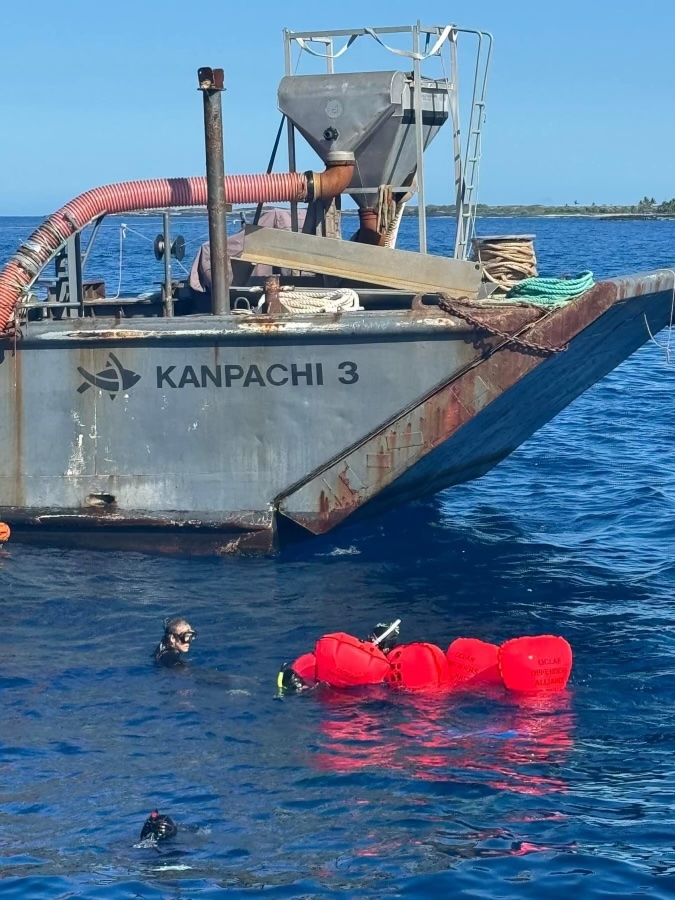Nearly 5 tons in tires removed from Kailua Bay
Kailua Bay is a vision of blue with regular sightings of a myriad of animals from spinner dolphins to humpback whales to the bright yellow tang.
But it’s a facade.

The bay has been a dumping ground for years, said Sarah Milisen, Hawai‘i Island Chapter leader for Ocean Defenders Alliance, a nonprofit dedicated to cleaning and protecting marine ecosystems. The ocean floor is littered with nets, old car parts, barrels, derelict fishing gear, glass and plastic bottles and trash in general.
Divers have also seen carcasses of vehicles, and most recently, a graveyard of tires.
The nonprofit regularly partners with tour operator Body Glove to conduct cleanups throughout the year where hundreds of pounds of debris are removed from Kona waters. On Earth Day, April 22, Ocean Defenders Alliance organized the largest cleanup of Kailua Bay where 61 tires were brought to the surface.
Sarah Milisen said the area where the tires were removed has an intact coral reef system with sandy patches.
In 60 feet of water, the nonprofit along with community partners and Body Glove hauled out the 4.5 tons of marine debris with the help of a crane from Blue Ocean Mariculture. Three vessels and between 30 and 40 people were involved in the operation.
“It was wild,” said Mikena Shay, sustainability coordinator with Body Glove, adding the majority of the tires were large, from semi tires to one or two airplane tires.
Tires were floated to the surface with the use of lift bags.
“This is the first time we’ve done anything like this and the biggest operation we’ve ever attempted,” said Jeff Milisen, member of the advisory board for the nonprofit Ocean Defenders Alliance.
Jeff Milisen discovered the mountain of tires — about a half mile offshore — by accident several weeks ago when he “miss-navigated” to an old wreck where he planned to create a 3-D image of the site.
He said there were nearly 90 tires that had been there for what he estimated at least 20 years.
“Tires are a triple threat of issues,” said Jeff Milisen. “Not only are they big and bulky and smash into corals, they’re filled with hundreds of chemicals.”
Jeff Milisen said it takes 5 gallons of oil to produce the average tire. When they end up in the water, the oil and chemicals leech out, killing larval fish.
Once surfaced, the bundled tires were tied off to a line attached to the Body Glove vessel.
“The amount of coordination to get them to the shoreline was immense,” Jeff Milisen said, adding it took a lot of effort and a lot of muscle.
In the weeks leading up to the cleanup, Shay said there were several prep dives to the site to bundle up as many of the tires as possible. The largest bundle had 11 to 12 tires. The average was seven tires per bundle.
After four weeks of doing prep work for the cleanup day, the tires were removed in two to three hours. After they were done, Shay said she sat underwater in awe at seeing the space nearly empty.
“You could really see and feel the difference. It was pretty incredible,” Shay said, adding the removal of the tires takes away another threat to the reef.
Jeff Milisen hopes this tire cleanup will be a model for future cleanups as there are still tires in the bay.
“It’s going to take some elbow grease to clean it up,” he said, adding the main concentration of tires is gone.
Before leaving, Jeff Milisen swam around to take a final mosaic photo. “It was difficult not to be brought to emotion. There were people who were brought to tears.”
Body Glove donated two boats, crew and lift bags. Blue Ocean Mariculture offered crew, crane ops, and landing craft for tires and offloading. Kona Honu Divers donated tanks and Kohala Divers donated regulators to the operation.
Junk Authority provided truck hauling of the tires and Big Island Scrap Metal gave reduced recycling rates.
“I can’t believe we accomplished our goal,” Sarah Milisen said.
Sponsored Content
Comments
















